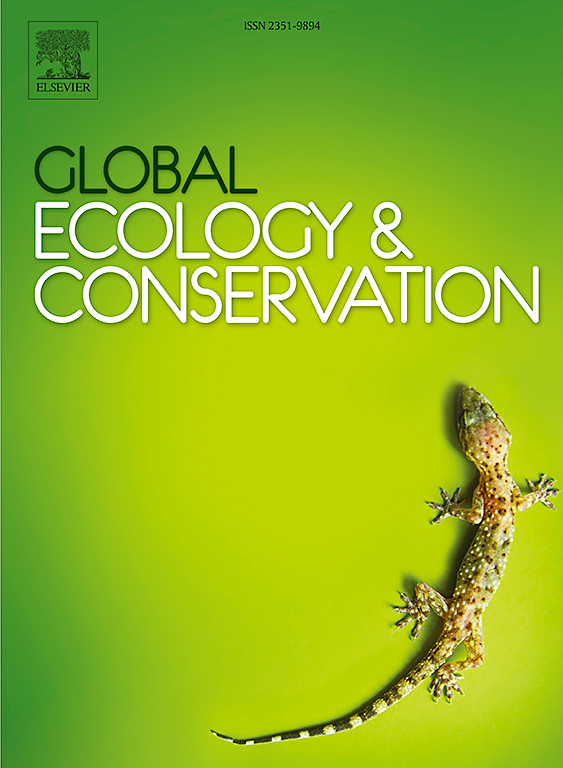青藏高原金沙江上游大型无脊椎动物群落沿海拔梯度和不同季节的分类与功能多样性
IF 3.4
2区 环境科学与生态学
Q1 BIODIVERSITY CONSERVATION
引用次数: 0
摘要
全面了解海拔梯度、生物群落的季节变化及其潜在驱动因素对于制定有效的水生环境保护和管理计划至关重要。然而,海拔格局和季节变化对高原地区大型无脊椎动物多样性的影响研究还不够。本文研究了青藏高原东南部金沙江上游地区大型无脊椎动物的分类和功能多样性。在金沙江上游,共鉴定出大型无脊椎动物166个分类群,隶属于3门5纲46科。丰水期平均丰度为132.5 ± 110.7 ind./m²,旱季显著增加至595.3 ± 559.0 ind./m²。广义线性模型(GLM)显示,在干湿季节,Shannon-Wiener指数和Simpson指数均随海拔升高而升高。相反,功能丰富度和Rao’s二次熵与海拔高度呈负相关。冗余分析表明,水温、电导率、pH和盐度是影响大型无脊椎动物群落组成的主要环境参数。此外,利用广义加性模型(GAM),我们发现水温和电导率显著影响大型无脊椎动物的功能多样性。研究表明,季节变化通过水温和电导率的波动驱动功能多样性,海拔梯度通过资源约束影响功能多样性。这些研究结果表明,有必要采取保护策略,减少青藏高原水生栖息地的外部干扰。本文章由计算机程序翻译,如有差异,请以英文原文为准。
Taxonomic and functional diversity of macroinvertebrate community along the elevation gradient and in different seasons in the upper Jinsha River (Qinghai-Tibet Plateau)
Comprehensive insights into the elevational gradients, seasonal shifts in biological communities, and their underlying drivers are critical for crafting effective conservation and management plans for these aquatic environments. However, studies on the impact of elevational patterns and seasonal changes on macroinvertebrate diversity in plateau regions remain insufficient. In this study, we investigated the distribution of macroinvertebrate taxonomic and functional diversity along an altitudinal gradient in the upper Jinsha River, southeast of the Qinghai-Tibet Plateau. In the upper Jinsha River basin, 166 taxa of macroinvertebrate were identified, encompassing 3 phyla, 5 classes, and 46 families. The average abundance was 132.5 ± 110.7 ind./m² during the rainy season and significantly increased to 595.3 ± 559.0 ind./m² during the dry season. Generalized linear models (GLM) revealed that the Shannon-Wiener and Simpson indices increased with elevation in both the wet and dry seasons. Conversely, functional richness and Rao's quadratic entropy exhibited a negative correlation with elevation. Redundancy analysis revealed that water temperature, electrical conductivity, pH, and salinity were the predominant environmental parameters shaping the composition of macroinvertebrate communities. Moreover, utilizing the generalized additive model (GAM), we discerned that water temperature and electrical conductivity significantly influence the functional diversity of macroinvertebrates. Our study demonstrated that seasonal variation drives functional diversity via fluctuations in water temperature and conductivity and elevational gradients influence functional diversity through resource constraints. These findings suggest the necessity for conservation strategies that reducing external disturbances in the aquatic habitats of the Qinghai-Tibet Plateau.
求助全文
通过发布文献求助,成功后即可免费获取论文全文。
去求助
来源期刊

Global Ecology and Conservation
Agricultural and Biological Sciences-Ecology, Evolution, Behavior and Systematics
CiteScore
8.10
自引率
5.00%
发文量
346
审稿时长
83 days
期刊介绍:
Global Ecology and Conservation is a peer-reviewed, open-access journal covering all sub-disciplines of ecological and conservation science: from theory to practice, from molecules to ecosystems, from regional to global. The fields covered include: organismal, population, community, and ecosystem ecology; physiological, evolutionary, and behavioral ecology; and conservation science.
 求助内容:
求助内容: 应助结果提醒方式:
应助结果提醒方式:


